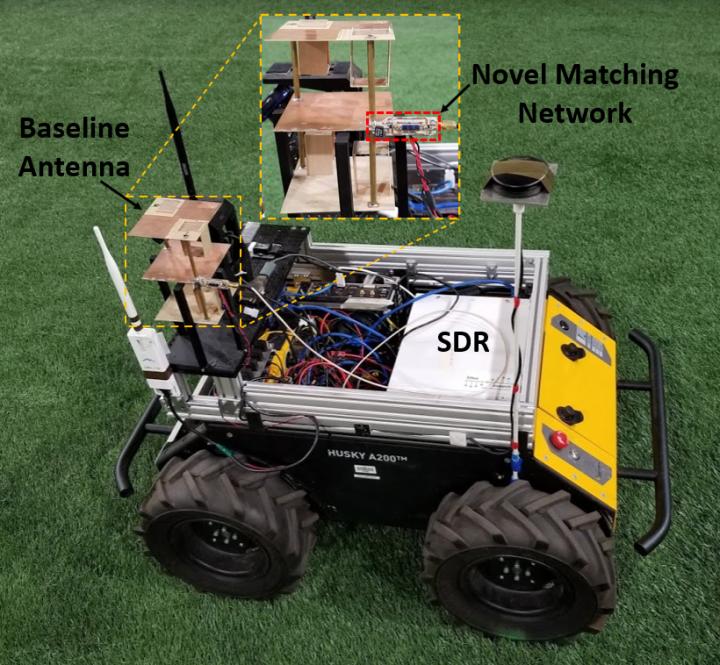
Credit: U.S. Army photo
ADELPHI, Md. — A new, miniature, low-frequency antenna with enhanced bandwidth will enable robust networking among compact, mobile robots in complex environments.
In a collaborative effort between the U.S. Army Combat Capabilities Development Command’s Army Research Laboratory and the University of Michigan, researchers developed a novel design approach that improves upon limitations of conventional antennas operating at low frequencies–demonstrating smaller antennas that maintain performance.
Impedance matching is a key aspect of antenna design, ensuring that the radio transmits power through the antenna with minimal reflections while in transmit mode–and that when the antenna is in receive mode, it captures power to efficiently couple to the radio over all frequencies within the operational bandwidth.
“Conventional impedance matching techniques with passive components–such as resistors, inductors and capacitors–have a fundamental limit, known as the Chu-Wheeler limit, which defines a bound for the maximum achievable bandwidth-efficiency product for a given antenna size,” said Army researcher Dr. Fikadu Dagefu. “In general, low-frequency antennas are physically large, or their miniaturized counterparts have very limited bandwidth and efficiency, resulting in higher power requirement.”
With those challenges in mind, the researchers developed a novel approach that improves bandwidth and efficiency without increasing size or changing the topology of the antenna.
“The proposed impedance matching approach applies a modular active circuit to a highly miniaturized, efficient, lightweight antenna–overcoming the aforementioned Chu-Wheeler performance limit,” said Army postdoctoral researcher Dr. Jihun Choi. “This miniature, actively matched antenna enables the integration of power-efficient, low-frequency radio systems on compact mobile agents such as unmanned ground and aerial vehicles.”
The researchers said this approach could create new opportunities for networking in the Army.
The ability to integrate low-frequency radio systems with low size, weight, and power–or SWAP–opens the door for the exploitation of this underutilized and underexplored frequency band as part of the heterogeneous autonomous networking paradigm. In this paradigm, agents equipped with complementary communications modalities must adapt their approaches based on challenges in the environment for that specific mission. Specifically, the lower frequencies are suitable for reliable communications in complex propagation environments and terrain due to their improved penetration and reduced multipath.
“We integrated the developed antenna on small, unmanned ground vehicles and demonstrated reliable, real-time digital video streaming between UGVs, which has not been done before with such compact low-frequency radio systems,” Dagefu said. “By exploiting this technology, the robotic agents could coordinate and form teams, enabling unique capabilities such as distributed on-demand beamforming for directional and secure battlefield networking.”
With more than 80 percent of the world’s population expected to live in dense urban environments by 2050, innovative Army networking capabilities are necessary to create and maintain transformational overmatch, the researchers said. Lack of fixed infrastructure coupled with the increasing need for a competitive advantage over near-peer adversaries imposes further challenges on Army networks, a top modernization priority for multi-domain operations.
While previous experimental studies demonstrated bandwidth enhancement with active matching applied to a small non-resonant antenna (e.g., a short metallic wire), no previous work simultaneously ensures bandwidth and radiation efficiency enhancement compared to small, resonant antennas with performance near the Chu-Wheeler limit.
The Army-led active matching design approach addresses these key challenges stemming from the trade-off among bandwidth, efficiency and stability. The researchers built a 15-centimeter prototype (2 percent of the operating wavelength) and demonstrated that the new design achieves more than threefold bandwidth enhancement compared to the same antenna without applying active matching, while also improving the transmission efficiency 10 times compared to the state-of-the-art actively matched antennas with the same size.
“In the design, a highly accurate model captures sharp impedance variation of the highly miniaturized resonant antenna” Choi said. “Based on the model, we develop an active matching circuit that enhances bandwidth and efficiency simultaneously while ensuring the circuit is fully stable.”
The team published their research, A Miniature Actively Matched Antenna for Power-Efficient and Bandwidth-Enhanced Operation at Low VHF, authored by Drs. Jihun Choi, Fikadu Dagefu, Brian Sadler, and Prof. Kamal Sarabandi, in the peer-reviewed journal Institute of Electrical and Electronics Engineers Transactions on Antennas and Propagation.
“This technology is ripe for future development and transition to our various partners within the Army,” Dagefu said. “We are optimistic that with the integration of aspects of our heterogeneous networking research, this technology will further develop and will be integrated into future Army communications systems.”
###
CCDC Army Research Laboratory is an element of the U.S. Army Combat Capabilities Development Command. As the Army’s corporate research laboratory, ARL is operationalizing science to achieve transformational overmatch. Through collaboration across the command’s core technical competencies, CCDC leads in the discovery, development and delivery of the technology-based capabilities required to make Soldiers more successful at winning the nation’s wars and come home safely. CCDC is a major subordinate command of the Army Futures Command.
Media Contact
Patti Riippa
[email protected]
Related Journal Article
http://dx.




